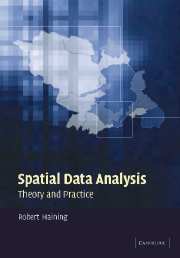Book contents
- Frontmatter
- Contents
- Preface
- Acknowledgements
- Introduction
- Part A The context for spatial data analysis
- Part B Spatial data: obtaining data and quality issues
- 3 Obtaining spatial data through sampling
- 4 Data quality: implications for spatial data analysis
- Part C The exploratory analysis of spatial data
- Part D Hypothesis testing and spatial autocorrelation
- Part E Modelling spatial data
- Appendix I Software
- Appendix II Cambridgeshire lung cancer data
- Appendix III Sheffield burglary data
- Appendix IV Children excluded from school: Sheffield
- References
- Index
3 - Obtaining spatial data through sampling
Published online by Cambridge University Press: 06 July 2010
- Frontmatter
- Contents
- Preface
- Acknowledgements
- Introduction
- Part A The context for spatial data analysis
- Part B Spatial data: obtaining data and quality issues
- 3 Obtaining spatial data through sampling
- 4 Data quality: implications for spatial data analysis
- Part C The exploratory analysis of spatial data
- Part D Hypothesis testing and spatial autocorrelation
- Part E Modelling spatial data
- Appendix I Software
- Appendix II Cambridgeshire lung cancer data
- Appendix III Sheffield burglary data
- Appendix IV Children excluded from school: Sheffield
- References
- Index
Summary
Spatial data are acquired in many different ways. In section 3.1 primary, secondary and other types of data sources are briefly reviewed. Section 3.2 considers the problem of obtaining data through spatial sampling. Section 3.3 briefly reviews simulation as a means of obtaining spatial ‘data’.
Most of the chapter is concerned with obtaining data through sampling. Three types of attribute properties, for which spatial sampling is often needed, are considered. The first is sampling to estimate global properties of an attribute in an area such as its mean value. This arises in estimating crop yield or the proportion of an area under a particular type of land use. The second is sampling for the purpose of constructing maps and making predictions of attribute values at specific locations. This arises when designing a sampling system for rainfall (e.g. rainfall by area) or predicting yields from mining. The third is sampling to detect areas with critically high (or low) values of an attribute (‘hot’ and ‘cold’ spots). This arises when seeking to detect land parcels that have been seriously contaminated.
The chapter deals only with attribute sampling. There are situations where a sample design is needed to represent some object such as the location of a line or the boundary of a lake. In geographic information system databases the representation and resolution of boundary lines between polygons is the product of a sampling process.
- Type
- Chapter
- Information
- Spatial Data AnalysisTheory and Practice, pp. 91 - 115Publisher: Cambridge University PressPrint publication year: 2003



